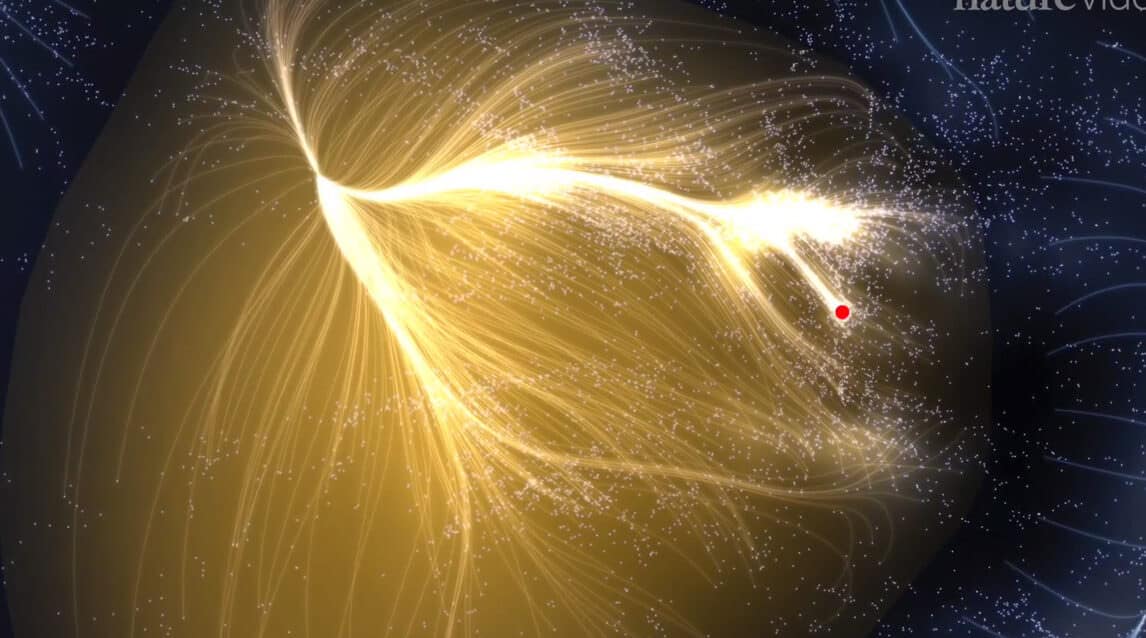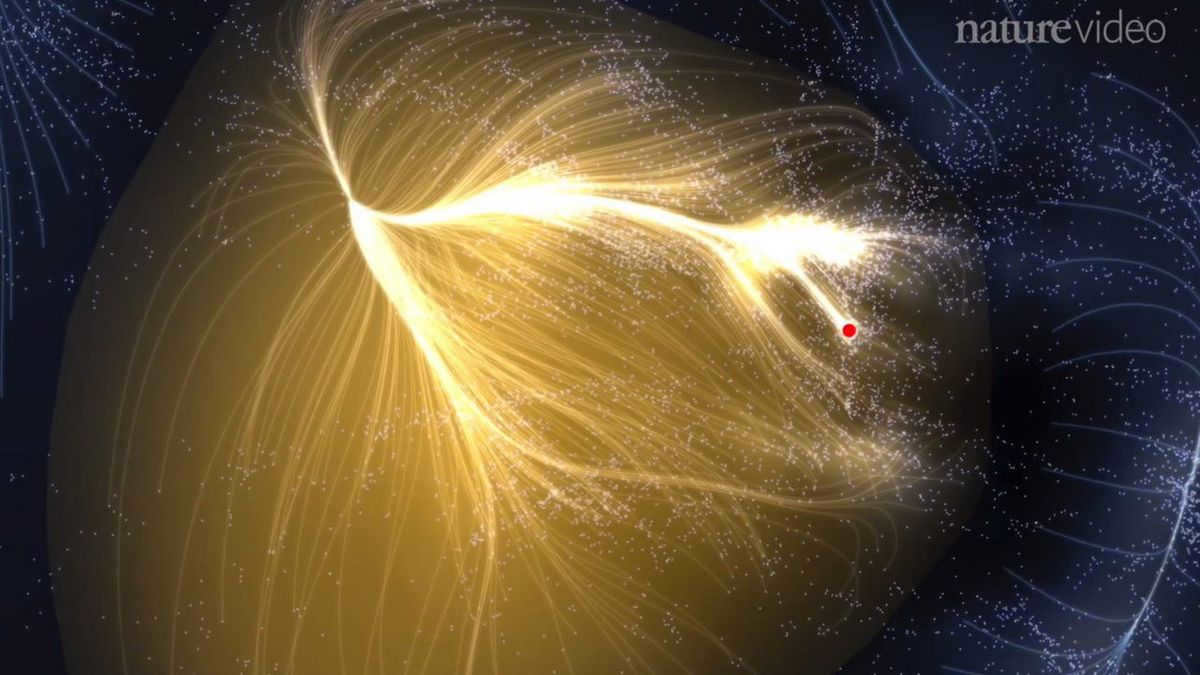
The largest known entity in the universe measures 10 billion light years across.
Scientists have identified a colossal assembly of galaxies known as the Great Wall of Hercules – Northern Crown as the most expansive structure in the universe. This colossal supercluster is so vast that it takes light approximately 10 billion years to traverse its entirety. To put this into context, the universe itself is estimated to be around 13.8 billion years old.
What is the significance of the word “big” in space?
When it comes to space, the concept of size is crucial.
While we perceive Earth as being substantial, with a circumference of approximately 40,075 kilometers around the equator, our understanding of the universe reveals that Earth is actually minuscule. Even within our own solar system, Earth is overshadowed by Jupiter, a planet that could accommodate over 1,300 Earths within its boundaries, and our Sun, which could contain more than a million Earths.
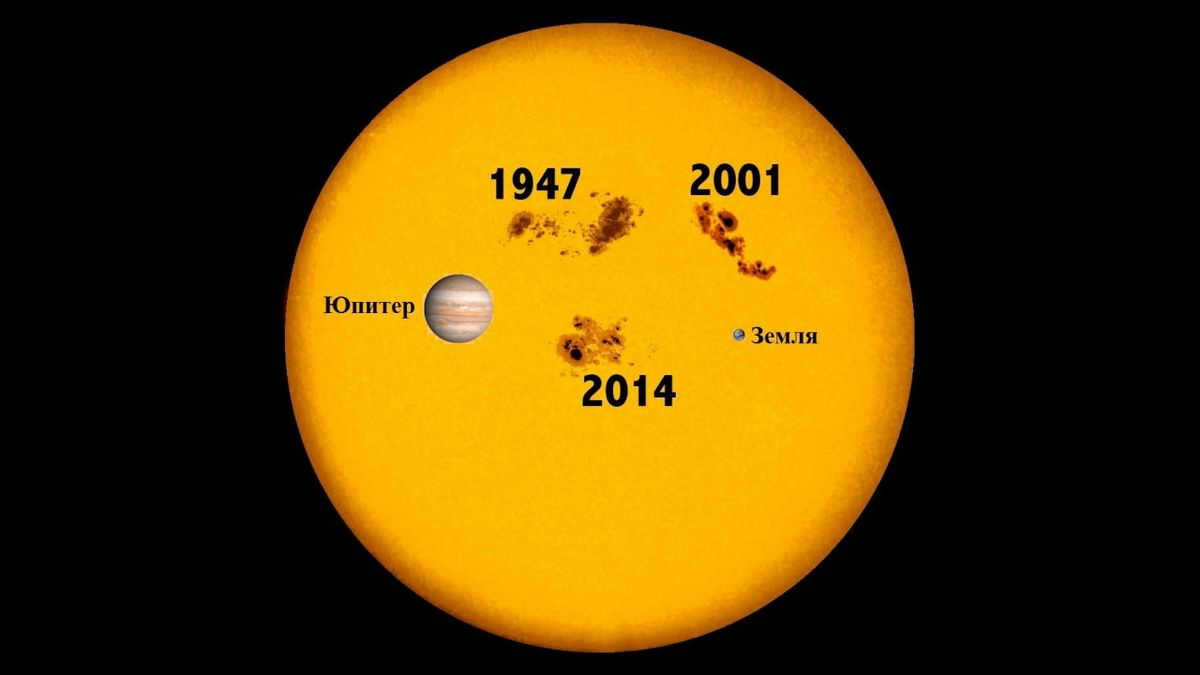
Other articles related to this topic:
Despite its immense size, our Sun appears minuscule when compared to the largest stars that we are aware of. The Sun is classified as a G-type star or a yellow dwarf and is considered to be of medium size on a cosmic scale. There are, however, “hypergiant” stars that are significantly larger. One example is Shields’ UY, which has a diameter capable of accommodating over 1,700 of our suns. Despite its enormous dimensions, UY Shield is only about 30 times more massive than our Sun. This discrepancy highlights the fact that volume and mass do not always correspond in the vastness of space.
There are even more enormous objects to take into account, such as black holes and specifically supermassive black holes, typically found at the core of a galaxy. For instance, within the Milky Way, there exists a black hole that surpasses the Sun’s mass by approximately 4 million times. NGC 4889, a galaxy, harbors one of the most colossal supermassive black holes ever observed, with a mass 21 billion times greater than that of the Sun. Nevertheless, despite their tremendous mass, black holes are not notably large, since they are the densest entities in the entire Universe.
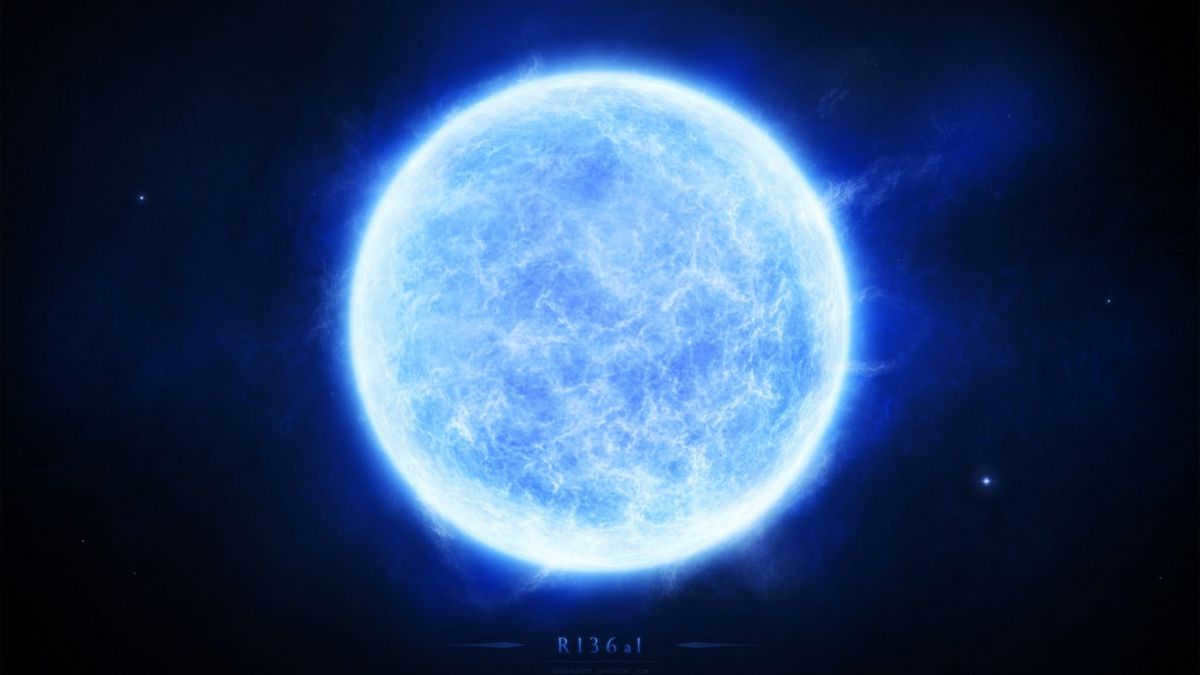
Nebulae, which are vast gas clouds that often condense to form new stars, are also remarkably large. NGC 604 in the Triangle Galaxy is commonly referred to as one of the most massive; it spans approximately 1,520 light-years.
Galaxies consist of clusters of star systems and all the celestial objects within them: black holes, planets, stars, asteroids, comets, gas, dust, and more. When viewed as a single entity, our own Milky Way has a diameter of over 100,000 light-years. Scientists face challenges in defining the boundaries of the largest galaxies as they do not have precise limits, but the largest known galaxies are millions of light-years in size.
According to NASA, the biggest galaxy ever discovered, initially explained in a 1990 research article published in the Science journal, is IC 1101, stretching across a staggering 4 million light-years.
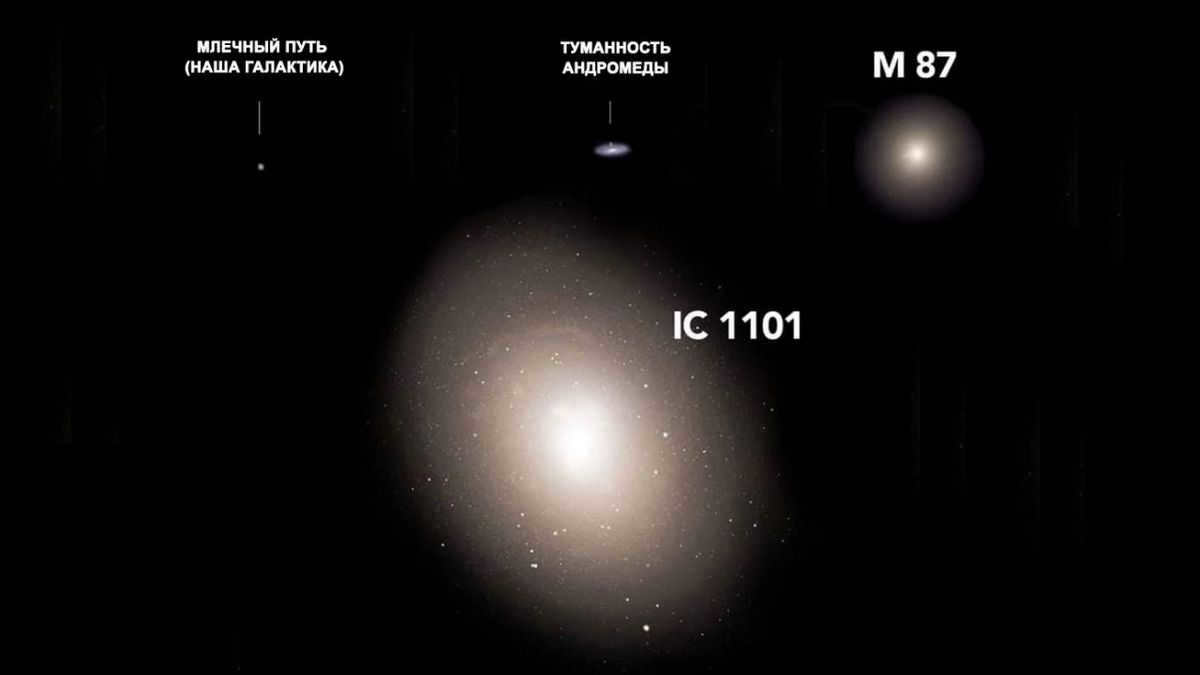
Galaxies are frequently held together gravitationally in clusters known as galaxy clusters. As an example, the Milky Way is part of a small Local Group consisting of approximately two dozen galaxies, including the Andromeda galaxy. At one point, astronomers believed these formations to be the largest entities. However, in the 1980s, scientists came to the realization that groups of galaxy clusters can also be held together by gravity, thus forming superclusters, which are the largest category of objects in the universe.
The Great Wall of Hercules-North Corona is without a doubt the most promising contender for the largest superunion ever discovered in the entire Universe. Astronomers have dedicated nearly a decade to researching and analyzing this extraordinary structure.
In 2013, a team of researchers, led by István Horváth from the National Public Service University in Hungary, made a groundbreaking announcement at the 7th Gamma-ray Burst Symposium in Huntsville. They unveiled their discovery of the Great Wall of Hercules-North Corona.
This awe-inspiring phenomenon was uncovered through the study of gamma-ray bursts, which are short-lived cosmic events believed to originate from the explosive deaths of massive stars, known as supernovae. These bursts are considered a valuable tool for detecting vast amounts of matter in the vast expanse of the universe. Horvath and his colleagues detected concentrated bursts of gamma rays approximately 10 billion light-years away, located in the direction of the constellations Hercules and the Northern Crown.
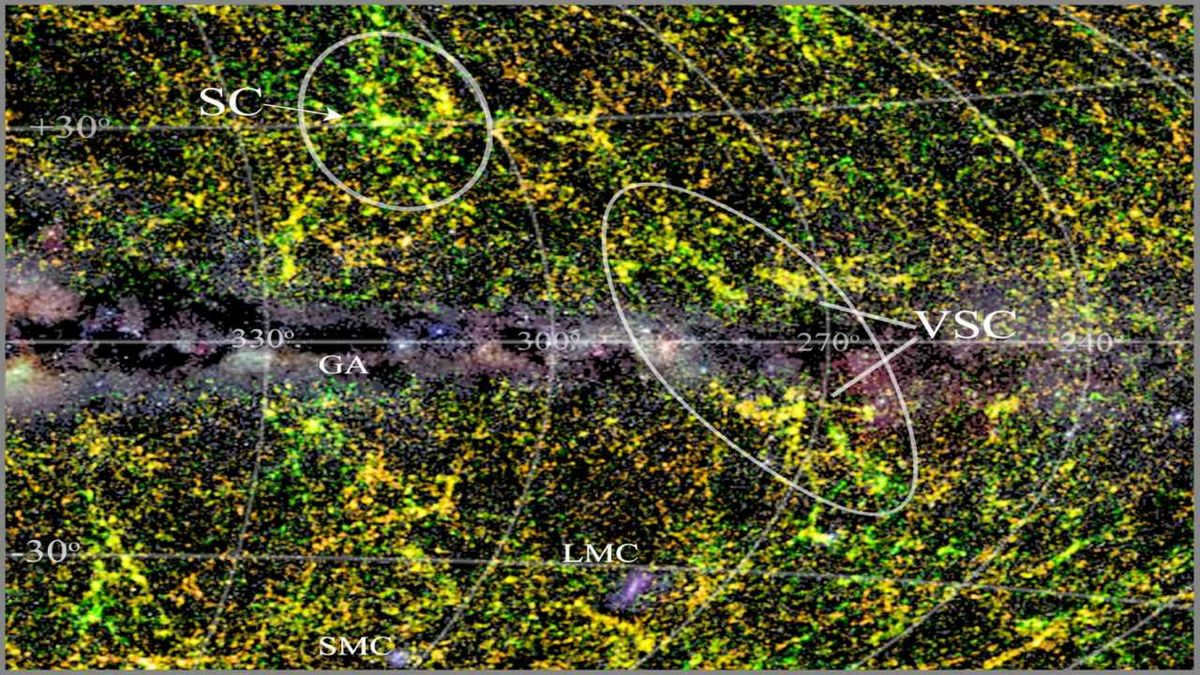
Nonetheless, the appearance of such an immense structure still remains an enigma to scientists. As per Horvath, this structure appeared to defy the principles of cosmology, which explain the formation and evolution of the universe. The said principle states that matter should exhibit homogeneity when observed on a large scale, yet the cluster displays heterogeneity.
“I would speculate that this structure is too colossal to exist. Even as a co-author, I still harbor skepticism,” commented John Hakkila, a researcher at the College of Charleston in South Carolina, in a press release back in 2014.
Nevertheless, Hakkila mentioned that there is an exceedingly low probability that the researchers observed a random occurrence of gamma rays at that particular location – far less than 1 percent.
“Hence, we are of the opinion that the structure is present,” he remarked. “There are other formations that appear to defy universal uniformity: the Sloan’s Great Wall and the Massive Cluster of Quasars. Therefore, it is possible that there are additional structures, and some of them may indeed be larger. Only time will determine.”
In a 2020 publication from the Monthly Notices of the Royal Astronomical Society, the existence of the Hercules-North Corona’s Great Wall was deemed “questionable at best,” with the suggestion that it could be a statistical anomaly within highly intricate data. However, the research team supporting the discovery of the supergroup substantiated their initial findings in their own 2020 paper published in the same journal.
What are the biggest entities in our solar system?
Despite being dwarfed by the enormous size of the Great Wall of Hercules-Northern Corona, the solar system does contain some significant objects. Here’s a supplementary compilation of colossal entities within our cosmic vicinity.
Biggest celestial body: Jupiter, boasting a diameter of approximately 142,984 kilometers, which is roughly 11 times larger than that of Earth.

The largest moon in our solar system is Ganymede, which circles around the planet Jupiter. It has a diameter of about 5,268 kilometers, making it slightly larger than the planet Mercury.
When it comes to mountains, the tallest one can be found on Mars. Olympus stands about 25 kilometers high, which is three times taller than Mount Everest on Earth.
If we talk about canyons, the largest one is Mariner Valley on Mars. It stretches over 3,000 kilometers in length, reaches up to 600 kilometers in width, and plunges to a depth of 8 kilometers.
As for craters, the largest one is located on Mars as well. Utopia Plain has an estimated diameter of 3,300 kilometers. It gained significance in 1976 when it served as the primary landing site for the Viking 2 spacecraft.

The largest asteroid in the solar system is Vesta, which measures 530 kilometers in diameter. It is located within the asteroid belt, situated between the orbits of Mars and Jupiter.
As for the largest dwarf planet, that title is held by Pluto, which has a diameter of 2,370 kilometers. Initially, it was believed to be smaller than the dwarf planet Erida. However, data collected by the New Horizons spacecraft in 2015 disproved this assumption.
Hello there! I am the creator and administrator of UniverseTodayRu. My passions lie in the field of astronomy, physics, and mathematics. I obtained my degree in 2010 from the Faculty of Physics and Mathematics at Pushkin BrSU. When it comes to observing and capturing images, I rely on the Sky-Watcher BK 909EQ2 telescope and the Canon EOS 1100D camera. During my spare time, you can find me gazing up at the stars, pondering what lies beyond. In addition to the exact sciences, I also have a keen interest in all things related to software and information technology.
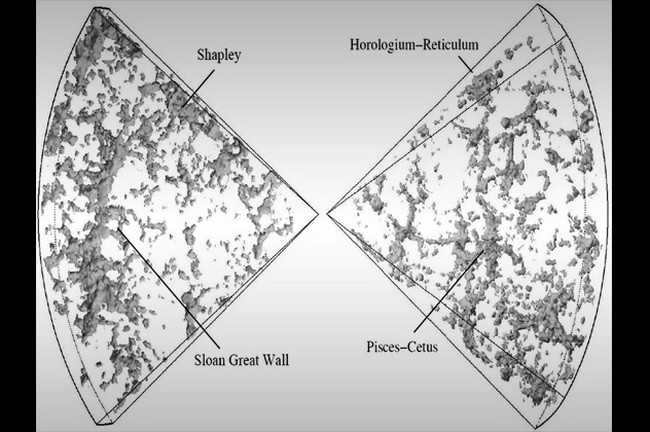
Discovered in 2003 as part of the Sloan Digital Sky Survey, the Great Wall of Sloan is a significant finding in the scientific community. This immense galactic filament, resembling the outstretched tentacles of an enormous octopus, spans across the Universe. Through the Sloan Digital Sky Survey, scientists were able to map hundreds of millions of galaxies and identify the presence of the largest objects in the universe. With a staggering length of 1.4 billion light-years, the Great Wall of Sloan was once regarded as the largest known entity in the entire universe.
The Great Wall of Sloan itself has not been extensively studied like the super-scopes contained within it. Some of these super-scopes are fascinating in their own right and warrant special recognition. One, for instance, exhibits a core of galaxies that collectively resemble enormous tendrils from an external perspective. Another showcases a notably high degree of galactic interaction, with many presently undergoing merger processes.
The existence of the “wall” and other larger entities raises new questions about the enigmas of the cosmos. Their presence defies the cosmological principle, which imposes theoretical constraints on the size of objects in the Universe. According to this principle, the laws of the Universe prohibit the existence of objects larger than 1.2 billion light-years. Nevertheless, entities such as the Great Wall of Sloan directly challenge this perspective.
The Massive LQG7 cluster of quasars.
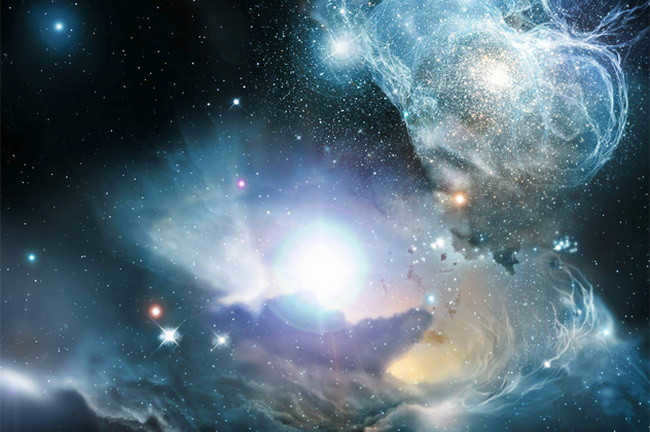
Quasars, which are celestial objects found at the core of galaxies, are believed to be centered around supermassive black holes that attract surrounding matter towards them. As a result, they emit an immense amount of radiation that is 1,000 times more powerful than the combined energy of all the stars within a galaxy. At present, the Huge-LQG group of quasars, consisting of 73 scattered across a span of 4 billion light-years, is considered to be the third largest entity in the universe. Scientists theorize that these massive quasar groups, along with similar ones, serve as the primary building blocks and sources for the largest structures in the Universe, such as the Great Wall of Sloan.
It is worth mentioning that the existence of Huge-LQG is still a subject of controversy. While certain researchers argue that this celestial area indeed constitutes a cluster of quasars, others maintain that the quasars in this part of space are haphazardly distributed and do not form a cohesive group.
A colossal ring of gamma-ray radiation
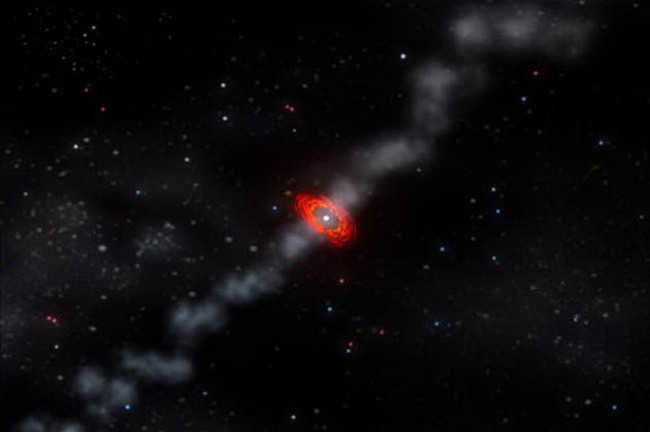
The Giant Galactic Gamma-ray Ring (Giant GRB Ring), which spans an impressive distance of 5 billion light-years, holds the title of being the second largest entity in existence. Aside from its immense size, this phenomenon stands out due to its peculiar configuration. Astronomers who have been investigating gamma ray bursts (enormous releases of energy resulting from the demise of massive stars) have discovered a sequence of nine bursts originating from the same distance from Earth. These bursts have formed a ring in the celestial sphere that is 70 times larger than the diameter of a full Moon. Considering the rarity of gamma ray bursts, the likelihood of them assuming a similar shape in the sky is estimated to be 1 in 20,000. Consequently, scientists have come to believe that they are observing one of the most colossal entities in the universe.
The term “ring” is simply used to describe the visual manifestation of this phenomenon when viewed from Earth. There are hypotheses suggesting that the enormous gamma-ray ring might be a projection of the sphere in which all gamma-ray bursts took place within a relatively brief timeframe of approximately 250 million years. However, this also raises the issue of what could have generated such a sphere. One possibility is that galaxies could gather around an immense accumulation of dark matter. Nevertheless, this remains purely speculative. The precise formation process of such structures still eludes scientists.
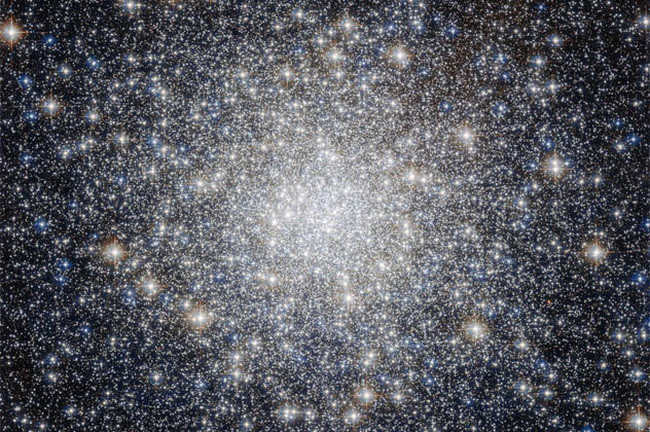
A group of astronomers have made a groundbreaking discovery in the world of gamma ray observations. They have identified the largest known entity in the cosmos, which they have named the Great Wall of Hercules-Northern Corona. This colossal structure stretches across an astonishing distance of 10 billion light-years, surpassing even the magnitude of the Giant Galactic Gamma-Ring. The reason behind this immense size is thought to be the presence of massive stars, which are known to produce the most powerful gamma ray bursts. These stars are typically found in regions of space where matter is more abundant, leading astronomers to compare each burst to the act of pricking a needle into a much larger object. Upon detecting an unusually high frequency of gamma ray bursts in a specific area near the constellations Hercules and the Northern Crown, scientists concluded that there must be an astronomical object present. This object is believed to be a densely packed cluster of galactic clusters, along with other matter.
Did you know that the name “Great Wall of Hercules – Northern Corona” was coined by a young Filipino teenager who added it to “Wikipedia”? Yes, anyone can make edits to this online encyclopedia. Soon after astronomers reported the discovery of a massive structure in the cosmic sky, an article with the same name appeared on “Wikipedia”. Although the name doesn’t accurately describe the object (the wall spans multiple constellations, not just two), it quickly gained popularity on the internet. This could be the first time that Wikipedia named a scientifically significant object that was discovered.
Furthermore, the existence of this “wall” challenges the cosmological principle and forces scientists to reconsider their theories about the formation of the universe.
The structure of the universe
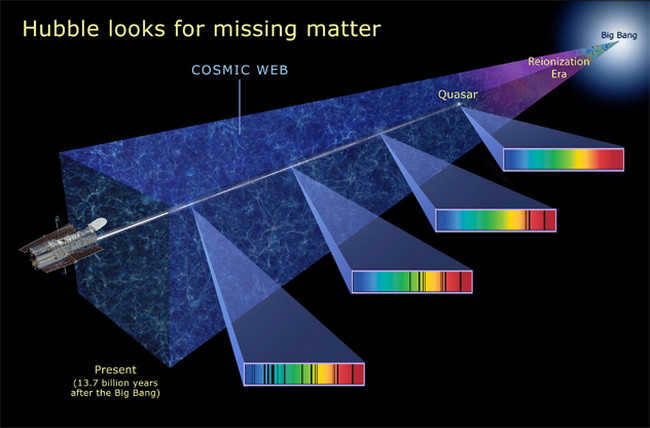
The expansion of the universe is not a random occurrence, according to scientists. There are theories suggesting that all the galaxies in the universe are arranged in a massive structure that resembles interconnected threads, connecting dense regions together. These threads, known as filaments, are interspersed among less dense areas. Scientists refer to this structure as the Cosmic Web.
It is only recently that scientists have come to understand the true nature of the Cosmic Web. Furthermore, they have even been able to detect its presence in the radiation emitted by a distant quasar that they have been studying. Quasars are known to be the brightest objects in the entire Universe. The light emitted by one of these quasars traveled directly along one of the filaments of the Cosmic Web, causing the gases within it to heat up and emit a glow. Based on these observations, scientists have been able to map out the filaments that connect various galaxies, creating a visual representation of the “skeleton of the cosmos”.
– 1 light second ≈ 300,000 km;
– 1 light minute ≈ 18,000,000,000 km;
– 1 light hour ≈ 1,080,000,000,000 km;
– 1 light day ≈ 26,000,000,000,000 km;
– 1 light week ≈ 181,000,000,000,000 km;
– 1 light month ≈ 790,000,000,000,000 km.
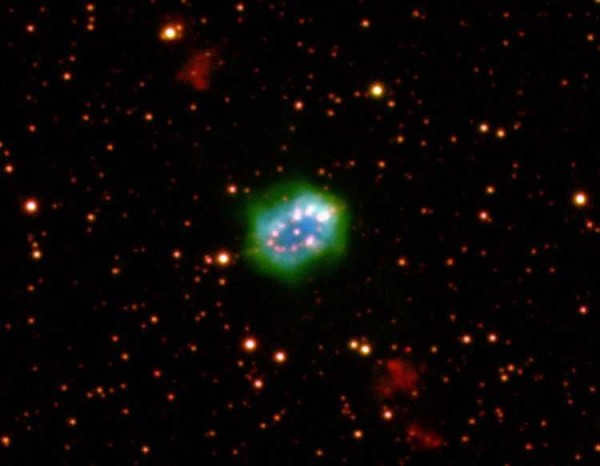
Gazing at the night sky filled with stars can captivate us endlessly. The enigmatic cosmic realm calls out for our attention. Within our galaxy, the movement of the stars is governed by specific laws, each phenomenon bearing a natural explanation. However, what we can observe through telescopes is merely a fraction of the vast universe, which expands with every passing second. It knows no boundaries. To the average observer, our galaxy also appears immense. Given this, a logical query may arise: “Which entity is larger – the galaxy or the Universe?”.
A magnificent abode of stars
Celestial entities held together by the forces of gravity form a galaxy. In the vast expanse of outer space, there exist countless “star abodes”. These stellar homes vary in size and age. Some are small galaxies, housing up to a billion luminous beings, while others are colossal stellar houses, accommodating trillions of celestial bodies.
An exemplary instance of such a colossal galaxy is NGC 6872, spanning a diameter of 500,000 light years.
Many stellar abodes are gravitationally bound, causing them to rotate in unison.
Categories
Every galaxy possesses its unique composition, arrangement, and form. Astronomer Edwin Hubble classified them into the subsequent categories:
Spiral
These configurations exhibit a spiral form, accompanied by a prominent disk, known as the nucleus. There are two variations: regular spiral and bar spiral. The latter type features a bar-shaped structure at the center, serving as the foundation for the arms. This bar arises due to centrifugal forces that divide the core into two segments.
The diameter of these stellar abodes ranges from 20,000 to 100,000 light years.
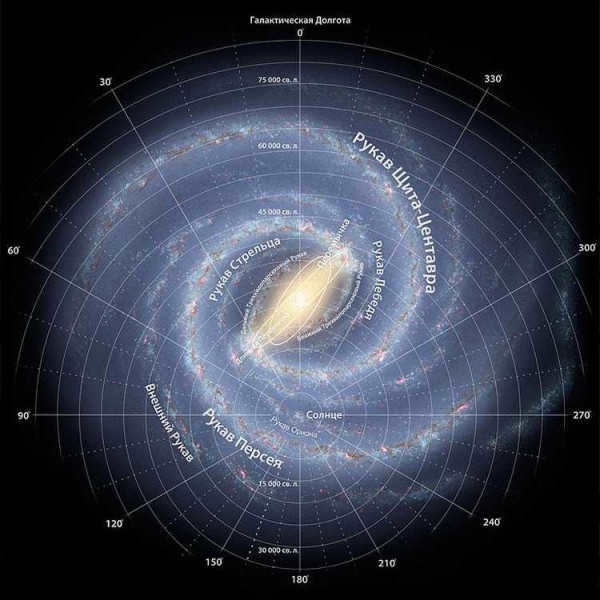
Elliptical Galaxies
Elliptical galaxies are a widely observed type of galaxy in the universe. They are characterized by their elongated shape and lack of arms and spirals. Elliptical galaxies come in a variety of sizes, ranging from small dwarf structures to massive objects with diameters measuring millions of light years.
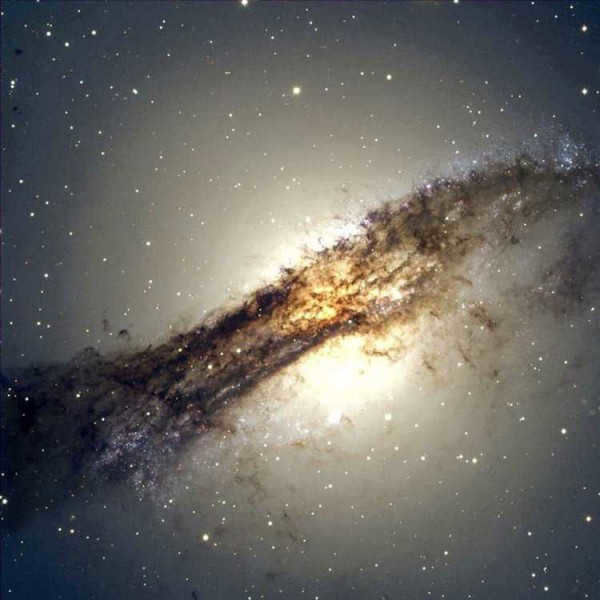
Uncommon
This is the most uncommon category. Entities of this kind lack a defined form and arrangement; they consist solely of groupings of stars and nebulae.

The Count of Galaxies in the Cosmos
Estimating the number of “stellar domiciles” in the vastness of outer space is a challenging task. Until a few years back, scientists had postulated that there were billions of them. Their calculations on the rate of celestial bodies forming after the occurrence of the Big Bang turned out to be inaccurate.
However, with the aid of data collected by state-of-the-art telescopes, a staggering two trillion galaxies have been identified. This count represents only the ones that the telescopes have managed to detect. Among these, 55% are classified as spiral star houses, 22% are categorized as elliptical, and a mere 5% fall under the irregular classification.
The Immense Scope of the Universe
The expansive realm of the cosmos, housing countless galaxies, numerous star systems, enigmatic black holes, vast voids, elusive dark matter, and more – this is the universe.
It likely harbors numerous other phenomena and entities that remain beyond our current understanding.
Anticipating new revelations is challenging, for the universe exists and evolves in its own enigmatic manner, in perpetual motion.
Scientists hypothesize that the inception of the Universe occurred due to the occurrence of the Big Bang. The age of the Universe is estimated to be around 14 billion years. Astonishingly, the Universe possesses boundless dimensions, rendering it an enigma that eludes complete comprehension. Its size undergoes constant flux, thereby thwarting any attempts to comprehensively investigate it. Numerous phenomena and celestial objects within its expansive expanse have yet to be thoroughly explored. Despite our perception as terrestrial observers, events within the Universe appear to unfold in a systematic and precise manner. Conceivably, within the vast expanse of space, a parallel world akin to our own might conceivably exist.
The distinction between the galaxy and the universe
There are significant disparities between these two concepts:
- The presence of counterparts. In the vastness of the cosmos, similar galaxies may exist, but the Universe is singular and unmatched.
- Limitations and proportions. A “stellar abode” possesses definite boundaries, which can extend beyond a few hundred light years. The Universe, on the other hand, is boundless and immense.
As a result of structural movements, the boundaries of the universe are expanding. Each object serves a vital purpose, adheres to specific laws, and is arranged in an orderly manner. This creates a sense of harmony and solidity within outer space.
- At its inception, according to the Big Bang theory, the universe was extremely hot, but as it expanded, its temperature gradually decreased. Scientists estimate that in the early stages of its formation, the temperature in outer space reached over a billion Kelvin.
- A global cold front is on the horizon as outer space continues to expand. This expansion causes the loss of valuable energy, resulting in a decrease in temperature and a potential halt to the expansion.
- We have an approximate understanding of the universe’s size. The circumference of outer space is estimated to be 150 billion light years, and its age is approximately 14 billion years. This data aligns with the rate of expansion observed.
- The vast cosmos lacks a discernible center, as it extends infinitely without any clear boundaries.
- The collision of stellar structures is unavoidable. Galaxies are in constant motion, constantly on the move. It is highly likely that at some point they will collide, resulting in a massive explosion that will even obliterate atoms.
- Its shape is flat. For a long time, scientists struggled to determine the shape of the universe. At one point, they believed it to be curved. However, the latest data reveals that it is actually flat, straight, and devoid of curves.
- The most luminous object in outer space is a Black Hole. Its immense gravitational force prevents light from escaping. As it spins, it engulfs celestial bodies and gas clouds, transforming them into a spiral shape. This gives the black hole its luminosity and brightness.
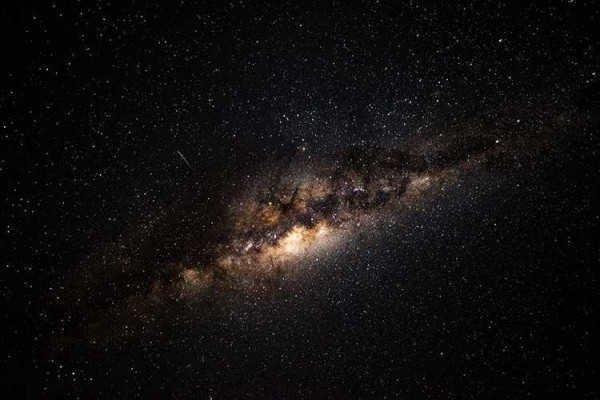
The Future of Space Exploration
Creating a comprehensive understanding of the vastness of outer space is an impossible feat. Our perception of the unknown world is limited to what we can visually observe and comprehend through our mathematical and astronomical knowledge. Each celestial object and structure operates according to its own set of laws. It is possible that the Andromeda galaxy could eventually consume the Milky Way, given its current velocity towards us at 300 m/s. Such an event would be catastrophic for both our galaxy and the entire universe.

The enormity of the Universe is beyond our comprehension. We, along with everything that exists around us, are merely minuscule components of this vast and all-encompassing concept. Furthermore, its implications extend far beyond the realm of astronomy and into the realm of philosophy.
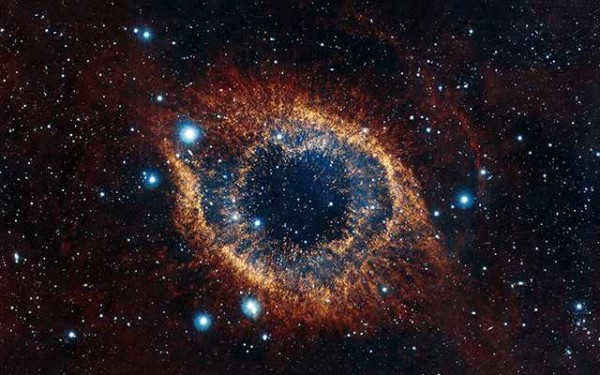
The philosophical aspect of the universe encompasses the entirety of the natural world, with no limitations in terms of time and space. It consists of various forms and states that matter assumes during its development.
Scientists define the astronomical aspect of the universe as the totality of everything that exists, including space, matter, time, and energy. This encompasses planets, stars, and all other celestial bodies. The size of the universe remains only partially comprehensible to scientists. Researchers have yet to discover an exact and concise definition of the Universe. It is possible that it is equivalent to God or other manifestations of the Supreme Intelligence.
In order to gain some insight into the vastness of the Universe, it is necessary to gauge the enormity of its various components. While it may be challenging for a human to fully comprehend the scale of the Earth, it is at least within our reach to encircle our planet. However, when we consider the immense size of Saturn, the Earth appears minuscule in comparison, akin to a coin next to a basketball. And when we further contemplate the magnitude of the Sun, our home planet becomes nothing more than a tiny seed.
The solar system itself is not of significant size compared to the vastness of the Universe. If we consider the heliosphere boundary as the edge of the system, it spans approximately 120 astronomical units. To put this into perspective, one astronomical unit is equal to approximately 150 billion kilometers. Now, try to imagine that the diameter of the entire Milky Way galaxy, which includes the Sun and its surrounding planets, is a staggering 1 quintillion kilometers. That’s a number with 18 zeros! Furthermore, this galaxy contains a cluster of celestial bodies, which, depending on different calculations, consists of anywhere from 200 billion to 400 billion stars, most of which are larger than our own solar luminary.
The Milky Way is not the sole galaxy within the vast expanse of the cosmos. Within Earth’s celestial canopy, visible to the unaided eye, are adjacent stellar clusters: Andromeda, the Large Magellanic Cloud, and the Small Magellanic Cloud. The measurements of their distances are expressed in megaparsecs, equivalent to millions of light-years. Each of these clusters extends to distances that are beyond the grasp of the human imagination.
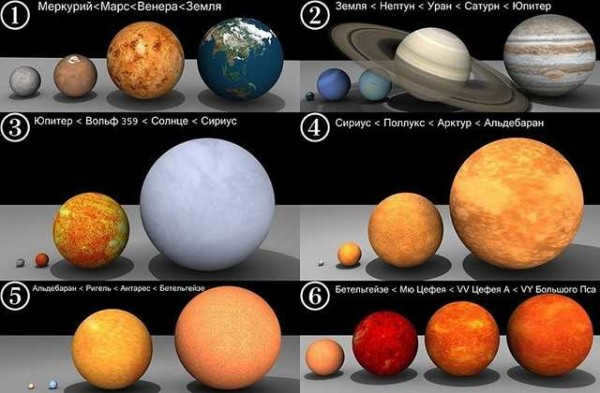
The Universe contains numerous clusters of stars, which are organized into expansive groups known as galaxies. One notable example is the Milky Way and its neighboring formations, which are part of the Local Group with a diameter of approximately 1 megaparsec. It is mind-boggling to think that a beam of light would require 3.2 million years to traverse the entire expanse of the Local Group from one end to the other.
However, this particular value is not the greatest. Clusters of galaxies, on the other hand, are arranged into superclusters or supercluster. These immense universal formations consist of numerous galaxy groups and countless star formations. For instance, the Virgo Supercluster, which encompasses the Milky Way, is comprised of over 100 galaxy groups. The extent of this formation measures over 200 million light-years, and this constitutes merely a fraction of the colossal Laniakea formation.
The Observable Universe and its Magnitude
The concept of the Observable Universe is incredibly intricate. As per Soviet geophysicist Friedman’s theory, the entire cosmic expanse is currently undergoing expansion. Simultaneously, all its components are moving apart at speeds exceeding that of light. In terms of Earth, the visible section of the universal vastness encompasses the boundless space from which radiation can reach us. However, it is possible that the source emitting the signal has already achieved faster-than-light velocity away from our galaxy, yet we continue to detect its radiation.
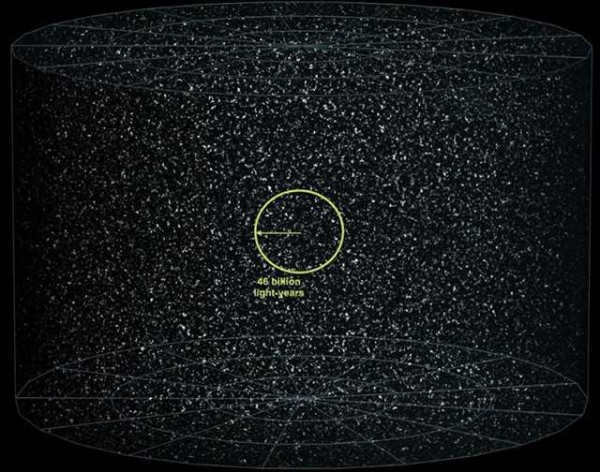
Do you ever wonder about the magnitude of the observable Universe? The cosmological horizon marks the limit of what we can see in the cosmos. Anything beyond this boundary emits radiation that never reaches our solar system. Determining the precise extent of the visible portion of the Universe proves to be a daunting task due to its continual and rapid expansion.
If we consider our star system as the focal point of the observable portion of the cosmos, and the surface of the relic radiation’s last scattering as the cosmological boundary, then the entirety of this sphere’s diameter will measure 93 billion light years. The Metagalaxy, a region of cosmic space that can be explored using contemporary astronomical tools, constitutes its structure. The metagalaxy is uniform and consistent, and scholars are currently discussing whether it represents the entire universe or merely a minute fragment of it. Its size is continuously evolving as astronomers enhance their technological capabilities.
Understanding the Nature and Scale of Space
When discussing the vastness of the cosmos, it is important to examine the concept of “space”. This term refers to a component of the universe that exists beyond the atmospheres and layers of celestial bodies. Contrary to popular belief, space is not an empty void. Instead, it is filled with interstellar matter comprising hydrogen molecules, oxygen, ionizing radiation, and electromagnetic energy. Moreover, scientists have long debated the presence of dark matter, theorizing that it serves as the elusive thread connecting the expanse of outer space.
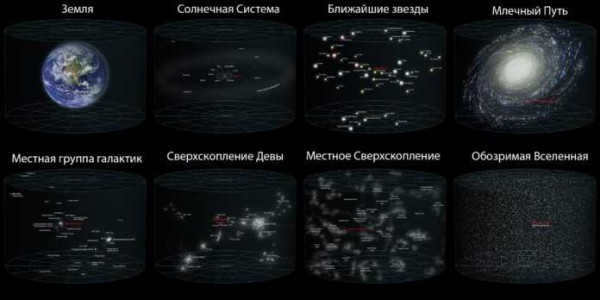
When it comes to our planet, modern astronomers classify space into the following categories:
- Near Space: This region starts at an altitude of approximately 19 kilometers, known as the Armstrong line. It is at this height that water boils at the temperature of the human body. If a person were to ascend to this altitude without a spacesuit, their saliva and tears would begin to boil. The international official boundary for outer space is considered to be just 100 kilometers above this point.
- Near-Earth space: This region is defined as the space within a height of about 260 thousand kilometers. At this altitude, the gravitational force of the Earth surpasses that of the Sun. It is within this range that our cosmonauts orbit and various satellites traverse.
- The interplanetary region is where the Moon, our natural satellite, orbits around the Earth. It is at these distances that only automatic space stations and NASA astronauts have flown during the Moon landing in 1970.
- The interstellar space is measured in billions of kilometers away from Earth.
- The intergalactic space, on the other hand, spans a distance of approximately 5 quintillion kilometers. When compared to the vastness of the universe, all of this is considered insignificant.
What is the size of the world?
After all of this literature, it’s worth pondering the immense size of our inhabited planet. In comparison to our solar system alone, humans are minuscule organisms, not to mention the vastness of galaxies and the cosmos. With that being said, the magnitude of the universe is inconceivable, and it is improbable that we will ever attain full knowledge of it.


Astonishing Trivia
There is a widespread belief that the Universe is boundless.
Within the immense expanse of the Universe, there exists an astonishing array of phenomena that can be easily identified but are almost impossible to fathom.
Countless phenomena outright defy the laws of physics, and a few of them will be explored in greater detail.
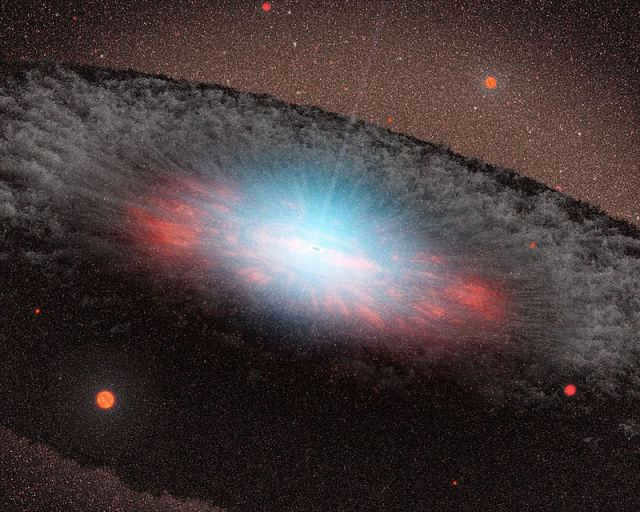
Nowadays, there are very few individuals who are not familiar with the concept of a “black hole”. In simple terms, a black hole is a specific area in space-time that possesses an incredibly strong gravitational pull. This gravitational pull is so intense that even objects traveling at the speed of light are unable to escape its grasp.
A supermassive black hole has the potential to possess a mass equivalent to 1 million to 10 million times the mass of our Sun. To put this into perspective, the mass of our Sun is 333,000 times greater than the mass of the Earth.
Up until now, only a small number of these black holes have been discovered. One example is known as Sagittarius A, which is situated at the center of our Milky Way galaxy. It boasts a mass of 3.7 million solar masses and a radius of less than 6.25 light hours. (For comparison, the dwarf planet Pluto is located 5.51 light hours away from our Sun.
2. Enormous star.
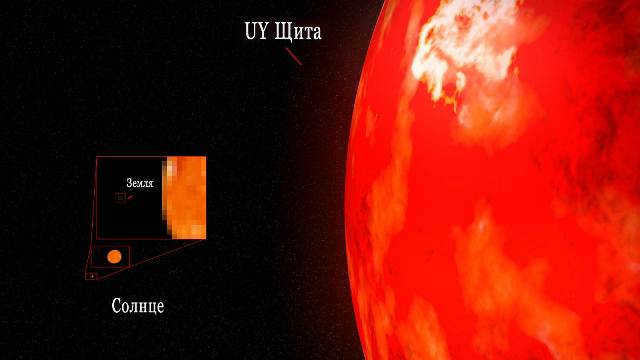
The size of our Sun is impressive, but in terms of size and brightness, it falls somewhere in the middle when compared to other stars.
Located approximately 9,500 light-years away, UY Shields is currently the largest and brightest star known to us. This star is classified as a red hypergiant.
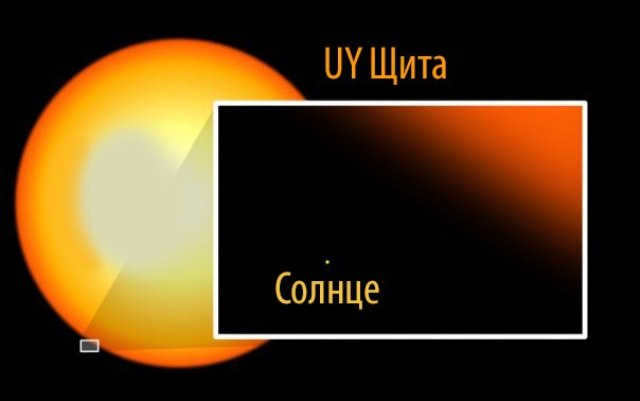
* The UY Shield has a size that is 1,708 times larger than that of the Sun.
* The UY Shield has a diameter of 2.4 billion kilometers.
* The UY Shield has a volume that is 5 billion times larger than the volume of our Sun.
* The UY Shield is 340,000 times brighter than the Sun.
What would happen if the UY Shield appeared next to us?
3. Magnetar
Magnetar is the third celestial body on our list.
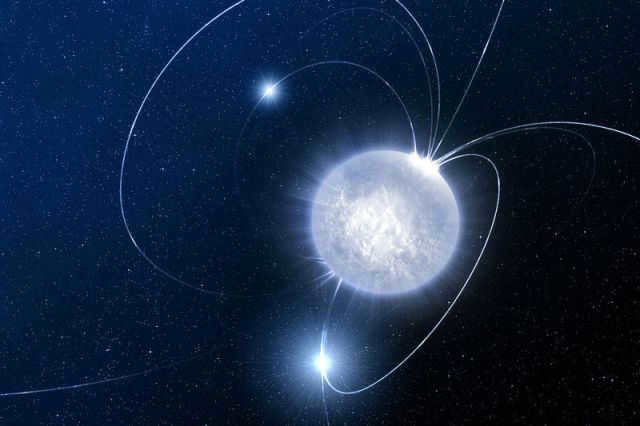
A magnetar is a type of neutron star that possesses the most powerful magnetic field in the entire Universe. These stars are formed through the explosive process of a supernova.
The lifespan of a magnetar is estimated to be around 1 million years, and currently, scientists have discovered a total of 11 magnetars.
Magnetars are still relatively unknown and understudied due to their distance from Earth. These celestial objects have diameters ranging from 10 to 30 kilometers, yet their mass exceeds that of our Sun.
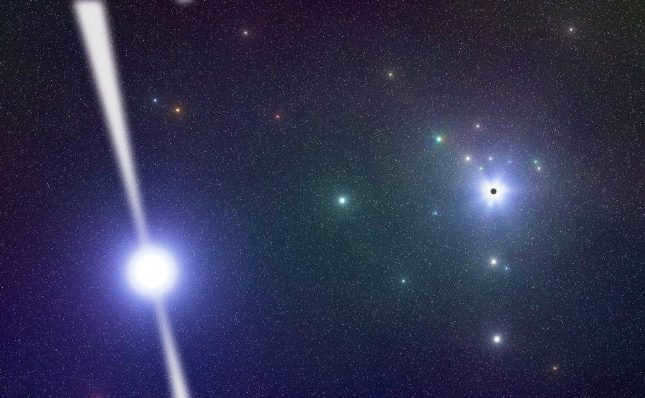
This particular star is incredibly dense to the point where its mass would exceed 100 million tons if it were the size of a pea.
During a typical flare that lasts only a few seconds, the amount of energy emitted by a magnetar can be equivalent to the energy produced by our Sun in an entire year.
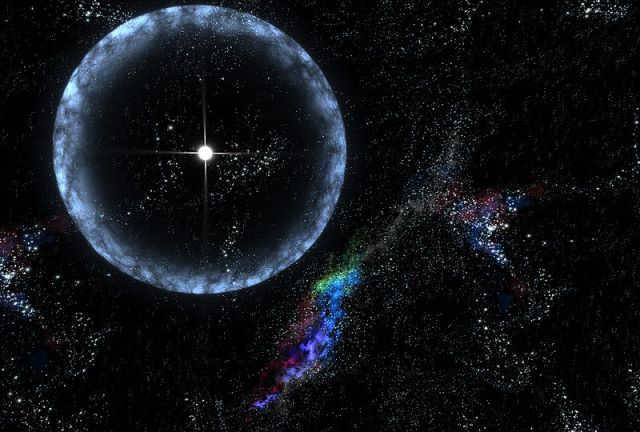

Gamma ray emission that arrived in our solar system
There is a hypothesis proposing that the intense energy releases from magnetars occur due to “starquakes,” a phenomenon where the crust of a neutron star fractures, leading to the expulsion of a powerful stream of protons from the star’s core. These protons are then trapped by a magnetic field, resulting in the emission of radiation observable in gamma-ray and X-ray imagery.

